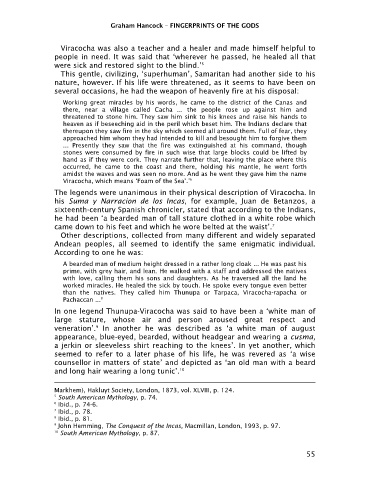Page 57 - Fingerprints of the Gods by Graham Hancock
P. 57
Graham Hancock – FINGERPRINTS OF THE GODS
Viracocha was also a teacher and a healer and made himself helpful to
people in need. It was said that ‘wherever he passed, he healed all that
were sick and restored sight to the blind.’
5
This gentle, civilizing, ‘superhuman’, Samaritan had another side to his
nature, however. If his life were threatened, as it seems to have been on
several occasions, he had the weapon of heavenly fire at his disposal:
Working great miracles by his words, he came to the district of the Canas and
there, near a village called Cacha ... the people rose up against him and
threatened to stone him. They saw him sink to his knees and raise his hands to
heaven as if beseeching aid in the peril which beset him. The Indians declare that
thereupon they saw fire in the sky which seemed all around them. Full of fear, they
approached him whom they had intended to kill and besought him to forgive them
... Presently they saw that the fire was extinguished at his command, though
stones were consumed by fire in such wise that large blocks could be lifted by
hand as if they were cork. They narrate further that, leaving the place where this
occurred, he came to the coast and there, holding his mantle, he went forth
amidst the waves and was seen no more. And as he went they gave him the name
Viracocha, which means ‘Foam of the Sea’.’
6
The legends were unanimous in their physical description of Viracocha. In
his Suma y Narracion de los Incas, for example, Juan de Betanzos, a
sixteenth-century Spanish chronicler, stated that according to the Indians,
he had been ‘a bearded man of tall stature clothed in a white robe which
came down to his feet and which he wore belted at the waist’.
7
Other descriptions, collected from many different and widely separated
Andean peoples, all seemed to identify the same enigmatic individual.
According to one he was:
A bearded man of medium height dressed in a rather long cloak ... He was past his
prime, with grey hair, and lean. He walked with a staff and addressed the natives
with love, calling them his sons and daughters. As he traversed all the land he
worked miracles. He healed the sick by touch. He spoke every tongue even better
than the natives. They called him Thunupa or Tarpaca, Viracocha-rapacha or
Pachaccan ...
8
In one legend Thunupa-Viracocha was said to have been a ‘white man of
large stature, whose air and person aroused great respect and
veneration’. In another he was described as ‘a white man of august
9
appearance, blue-eyed, bearded, without headgear and wearing a cusma,
a jerkin or sleeveless shirt reaching to the knees’. In yet another, which
seemed to refer to a later phase of his life, he was revered as ‘a wise
counsellor in matters of state’ and depicted as ‘an old man with a beard
and long hair wearing a long tunic’.
10
Markhem), Hakluyt Society, London, 1873, vol. XLVIII, p. 124.
5 South American Mythology, p. 74.
6 Ibid., p. 74-6.
7 Ibid., p. 78.
Ibid., p. 81.
8
9 John Hemming, The Conquest of the Incas, Macmillan, London, 1993, p. 97.
10 South American Mythology, p. 87.
55

